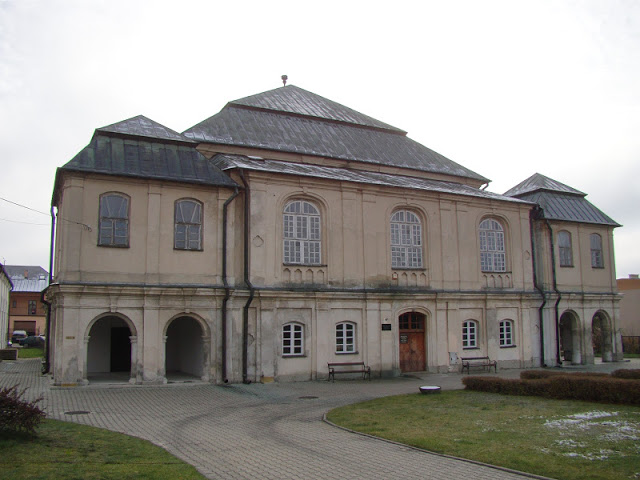 |
"The
Great Synagogue" of Wlodawa
completed in 1774. Just 5 miles from
Death Camp Sobibor.
Although there are supposedly no
Jews now living in the town,
shopkeepers all observe Shabbat. |
"Włodawa
... is a town in eastern Poland on
the Bug River, close to the borders
with Belarus and Ukraine. ... As of
2011 it has a population of 14,800.
The existence of a Jewish community
in Włodawa is first recorded in
connection with the Lublin fair of
1531. ... For much of the early
modern period, a time when the
Polish-speaking community of the
region was predominately engaged in
agriculture (meaning
they were serfs), Jews appear to
have composed much of the population
of the city, engaged in all forms of
craft production and trade. ...
There were 2,236 Jews in 1827 and
6,706 in 1907. ... In the late 19th
century ... Of the 184 stores in the
town, 177 were owned by Jews.
... Włodawa was over 70% Jewish
before WWII and the Holocaust." wikipedia
I thought I'd share my photos of the
Polish town of Włodawa, where I stayed
for two nights in late October 2012,
whilst I was visiting the Sobibor camp,
which is around 5 miles south of the
town. I was fortunate enough to meet a
young woman there who had worked in the
U.K. for numerous years, so spoke fluent
English, and she was able to tell me a
few interesting things about the town.
I arrived in Włodawa around noon on a
Saturday, and soon noticed that all the
shops were closed, which I thought
rather strange. They remained closed on
Sunday as well, but as I was in the
back-of-beyond in an overwhelming
Catholic country, I could understand
that.
I was told by the young woman, that as
far as she knew, everything had always
closed in Włodawa on a Saturday, but she
genuinely seemed not to know why. Later
she told me that prior to the war, the
entire town had been owned by Jews (once
by one family, the Czartoryskis, see
below). She explained that all the old
buildings (pre-war) around the town
(photos below), had been owned by Jews
(even wikipedia almost agrees).
I put it to her that that was the likely
reason for everything closing on a
Saturday, she said "Shabbat!", and
laughed, but I could tell she knew it
made sense.
Wikipedia states:
"Traditionally the Bug (river, on
which Włodawa is situated) was
also often considered the ethnographical
border between Orthodox and Catholic
peoples." and the young women told me
that Włodawa was known as the 'town of
three cultures', meaning Catholic,
Orthodox and Jewish. I'd later see a
large graffiti mural (clearly an
approved and likely commissioned one)
which confirmed this (photo below).
 |
|
The
river Bug, as viewed from Poland. On
the far bank is Belarus. |
 |
|
The
Great Synagogue |
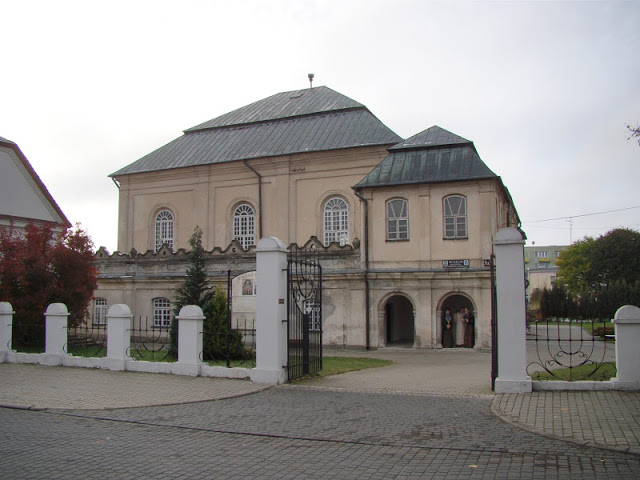 |
|
From
another angel. Notice the menorah
style fence, I saw the very
same, surrounding a synagogue in
the stunningly beautiful town of Zamość |
 |
|
Another angel still |
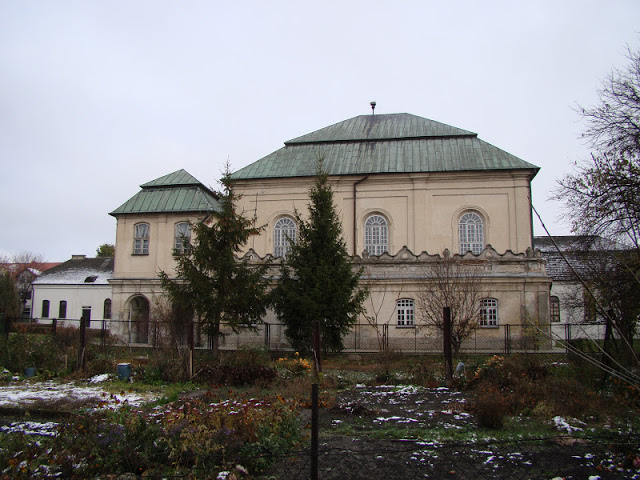 |
|
And
from the fourth side |
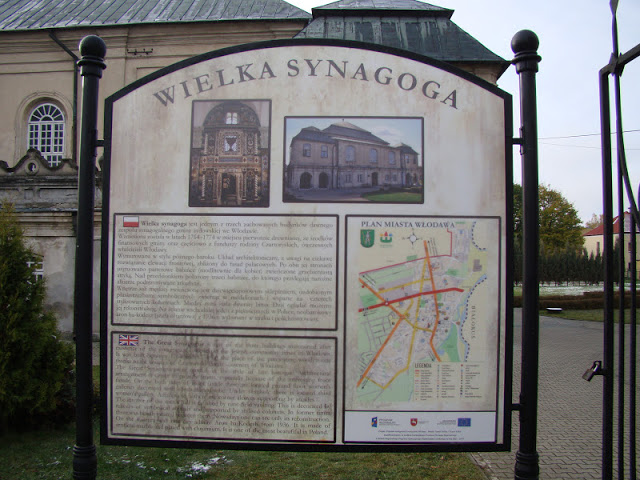 |
|
Wielka Synagoga = Great Synagogue,
the English text reads: |
The Great Synagogue is one of the
three buildings maintained after
existence of the synagogue complex
in the Jewish community times in
Wlodawa. It was built between 1764
and 1774 in the place of the
preexisting wooden one thanks to the
sources of Czartoryski family —
owners of Wlodawa.
The Great synagogue was erected in
the style of late baroque.
Architectural arrangement is closer
to palace's fronts, especially
because of the interesting front
fasade. On the both sides of front
fasade there are located ground
floor women's galleries decorated
with comb-shaped attic. Under
vestibule there is located third
women's gallery. Adjacent to it
there are corner alcoves supporting
by arcades.
The interior of the men's hall is
finished by nine-field vaulting.
This is decorated by relieves of
symbolical animals and supported by
stylised columns. In former times
there was bimah licated between
them. Nowadays one can see only its
reconstruction. On the Eastern wall
once can admire Aron ha-Kodesh from
1936. It is made of artificial
marble and plated with chromium. It
is one of the most beautiful in
Poland.
 |
|
Next
to the Great Synagogue (left) is the
Small Synagogue |
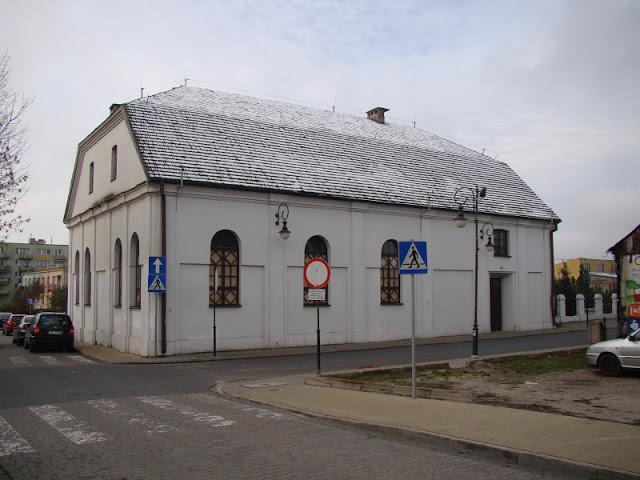 |
|
The
Small Synagogue |
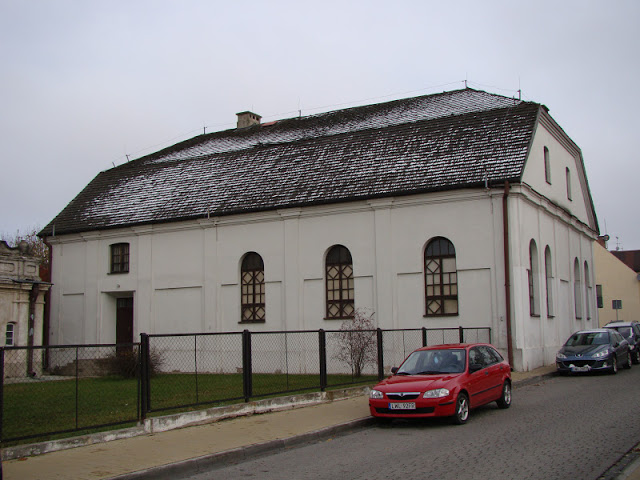 |
|
From
the other direction |
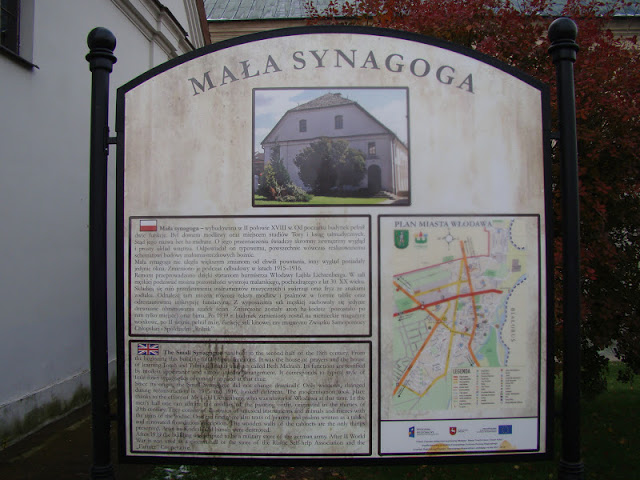 |
|
Mała
Synagoga - Small Synagogue, the
English text reads: |
The Small Synagogue was built in the
second half of the 18th century. From
the beginning this building fulfilled
two functions. It was the house of
prayers and the house of learning Torah
and Talmud. That is why it is called
Beth Midrash. Its functions are
testified by modest appearance and
simple interior arrangement, It
corresponds to typical style of
little-town synagogues commonly applied
at that time.
Since its origin, the Small Synagogue
did not change drastically. Only
windows, changed during reconstruction
in 1915 and 1916, looked different. The
modernisation took place thanks to the
effort of Mr Lajbl Lichtenberg, who was
mayor of Wlodawa at that time. In the
men's hall one can admire the residues
of the painting outfit originated in the
thirties of 20th century. they consist
of illustrates of musical instruments
and animals and friezes with the signs
of the zodiac. Once can find there also
texts of prayers and psalms written as a
tables and renovated foundation
inscription. The wooden walls of the
cabinets are the only things preserved.
Aron ha-Kodesh and bimah were destroyed.
After 1939 the building was adapted to
be a military store of the german army.
After II World War it was used as a
cinema-hall or the store of the Rustie
Self-help Association and the ,,Farmer''
Cooperative.
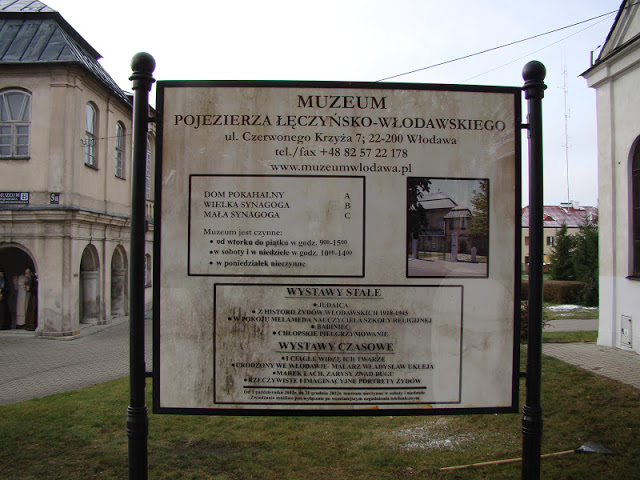 |
|
To
the left of the sign is the Great
Synagogue, and to the right is the
Wlodawa museum, that I didn't take a
photo of, for some reason. But I
took a photo of its sign (below) |
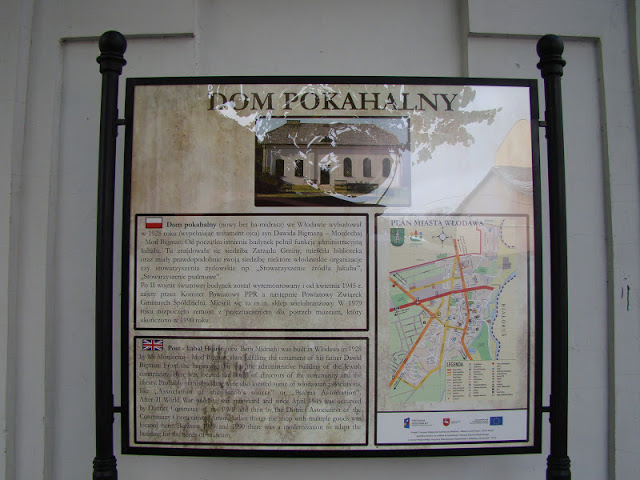 |
|
New
Beth Midrash, now the local museum,
the English text reads: |
Post - kahal House (new Beth Midrash)
was built in Wlodawa in 1928 by Mr
Mordechaj - Motl Bigman, thus fulfilling
the testament of his father Dawid
Bigman. From the beginning thos was the
administrative building of the Jewish
community. Here was located the board of
directors of the community and the
library. Probably in this building were
also located some wlodawian associations
like ,,Association of the Jacob's
source'' or ,,Psalms Association''.
After II world War building was
renovated and since April 1945 was
occupied by District Commitee of the PWP
and then by the District Association of
the Community Cooperatives. Among other
things the shop with multiple goods was
located here. Between 1979 and 1990
there was a modernization to adapt the
building for the needs of the museum.
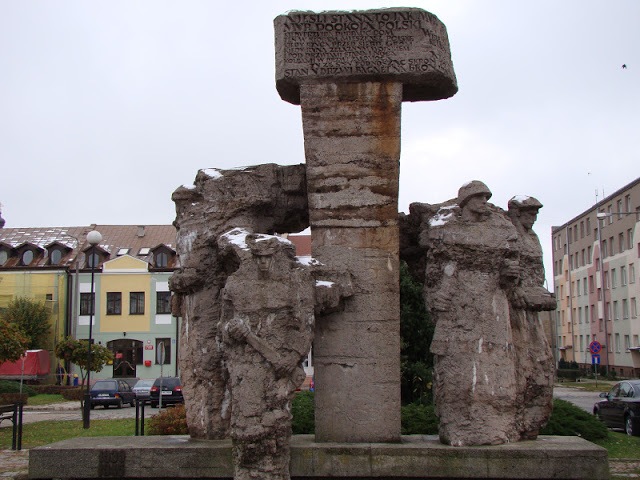 |
|
A
typically ugly Soviet memorial |
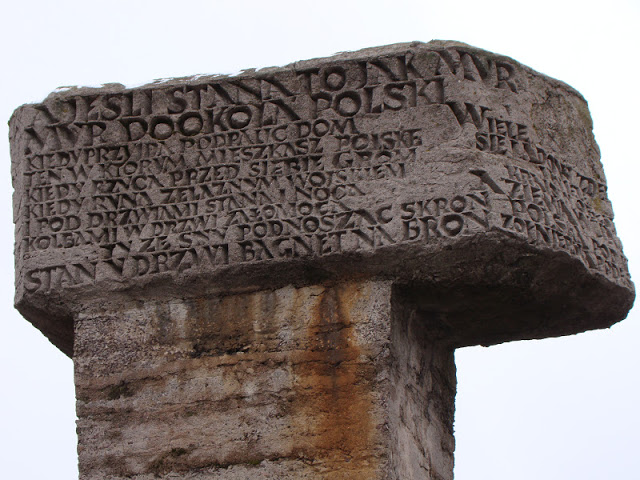 |
|
Translations welcomed |
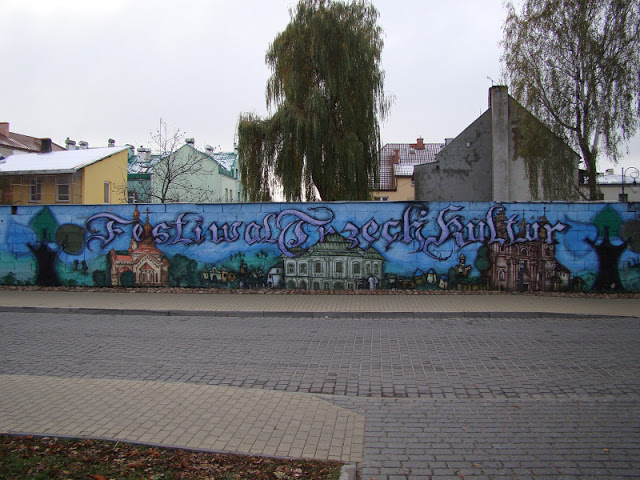 |
|
The
mural, it reads: Festiwal Trzech
Kultur (Festival of Three Cultures),
depicting (L-R) the Orthodox church,
Great Synagogue and Catholic church |
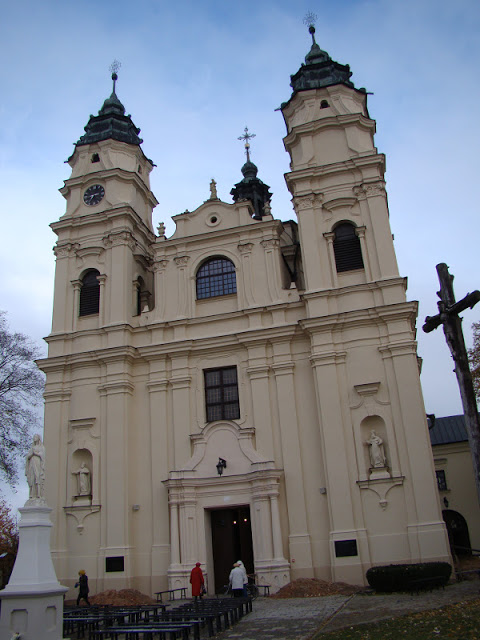 |
|
Church of St. Louis (Catholic) |
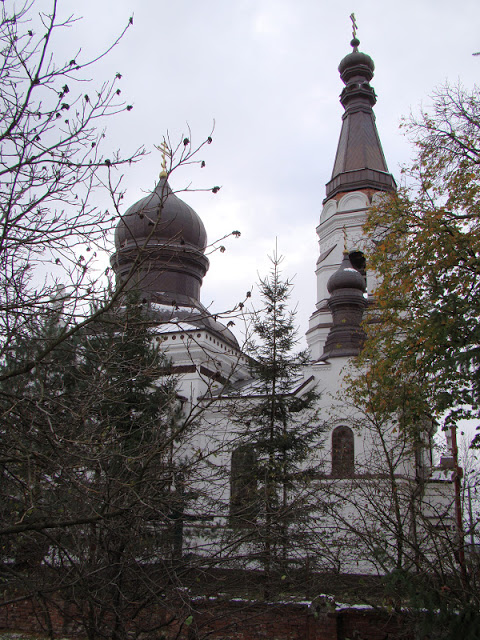 |
|
Orthodox church |
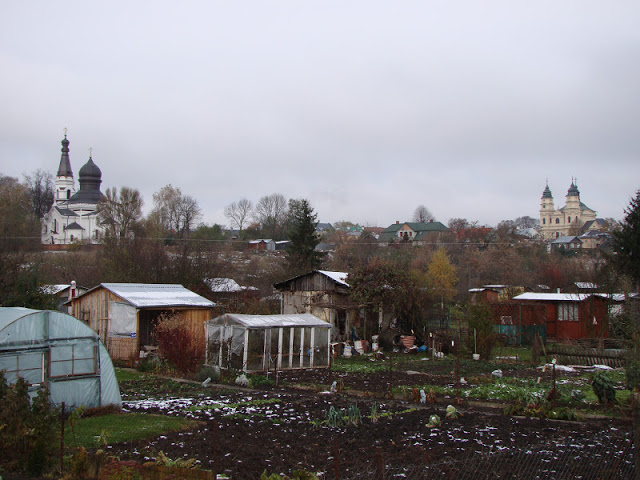 |
|
Orthodox church on the left, and
Church of St. Louis on the right. I
took this picture on the bank of the
river Bug |
 |
|
This
might be the "Jewish-owned
steam-powered flour mill" wiki |
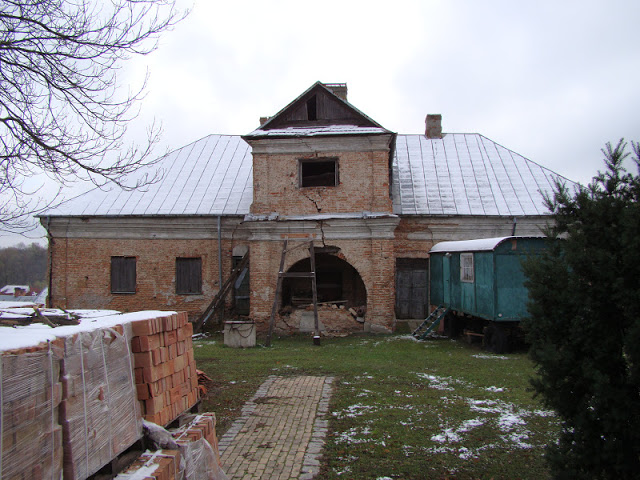 |
|
View
from the front |
Wikipedia and this other
site, claim the 18th century Jewish
cemetery in Wlodawa was destroyed by the
Nazis, who used the tombstones for
"laying the pavements and for regulating
the Włodawka River"!
The Jewish Cemetery Project states that
Wlodawa had three Jewish cemeteries:
-
Established 16th century, last burial
17th century. This one was next to the
Great Synagogue picture above, in fact,
it's probably in the foreground of this photo.
-
Established in the 18th century, last
burial early 19th century. This one was here. Wikimedia has
two photos.
-
Established in the 19th century, last
burial 1943. I'm not sure where this one
was. This site claims
one was here,
but date it to the 18th century.
Supposedly all three of these cemeteries
were vandalised during WWII, and
presently there are no tombstones at any
of them.




































The Polish sense of aesthetics leaves a lot to be desired. The plaster always unpainted and breaking off the walls, satellite dishes hanging everywhere, adverts for cigarette brands. The Poles lost their middle and upper classes in the 20th century; a lot of them ended up in Katyn.
ReplyAnyone who has been to the towns on the Oder Neisse border knows the different aesthetics although it must be said that a lot of the towns like Stettin, Breslau, etc were populated by a mixture of Roma gypsies, ukranians and red refugees from Greece and Spain....not a good mix.